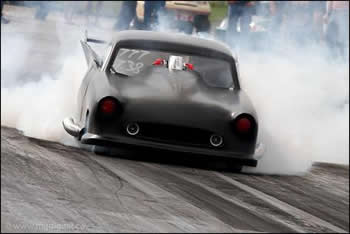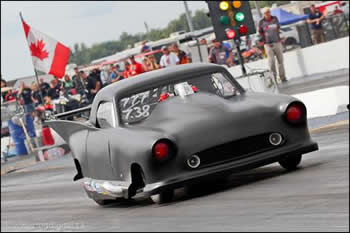Metropolitan-body Top Sportsman features twin-turbo Chevy power
GUELPH, ONTARIO (January 25, 2012)
– Wes Goddard may have one of the older car body styles in the Quick
32 Sportsman Series, but underneath his 1958 Nash Metropolitan is
state-of-the-art in drag racing.
 Powered
by a 509-cubic inch Chevrolet engine, Goddard's Nash sports a set of
twin 76-millimeter Precision Turbochargers which can power the 101-inch
wheelbase down the quarter mile at speeds over 200 mph.
Powered
by a 509-cubic inch Chevrolet engine, Goddard's Nash sports a set of
twin 76-millimeter Precision Turbochargers which can power the 101-inch
wheelbase down the quarter mile at speeds over 200 mph.
This
season will be the first full year for the Top Sportsman car, which
was assembled last year and saw limited use in Quick 32 Sportsman
Series presented by NAPA Auto Parts action.
"It's
been lots of learning," noted Goddard, who is not only the driver of
the Hell Billy Racing entry, but performs crew chief duties as well.
"The car was all brand new when we got it down the track late last year
at Cayuga.
"But
the power is not an issue," he continued. "I was able to go 200 mph
with the gates (wastegates on the turbochargers open). With everything
in order, we should be getting 2400 horsepower."
The
engine was built by fellow series competitor Fred DeJonge, who lives
in Puslinch, Ontario, just down the road from Goddard's home town of
Guelph. Goddard's brother Frank drives the DeJonge car, which is also a
twin-turbocharged car, but carries larger 88-mm turbos.
 "We've
got the smaller turbos as I want to bracket race the car as well,"
said Goddard. "The smaller turbos spool up faster, and I'm hoping no
body will be able to burn me down at the line."
"We've
got the smaller turbos as I want to bracket race the car as well,"
said Goddard. "The smaller turbos spool up faster, and I'm hoping no
body will be able to burn me down at the line."
Building
the power in turbocharged engines is different than a supercharged
engine, and the boost must be built up with engine revs on the starting
line. The longer the build-up, the stronger the engine gets, but the
possibility of internal havoc inside the engine increases before the
green light is shown on the tree.
"If
the tune-up is good, and the engine and turbos are within their
parameters, the engine should be pretty good," Goddard said, adding
that maintenance can be less with a turbocharged engine if all is set up
correctly.
The
fuel system on the car is a Big Stuff 3 unit, and a Powerglide
two-speed sits behind the engine. Goddard built the car's chassis
himself, as well as the unique body, building a mold of an original
Metropolitan body and then casting the fiberglass unit.
Goddard
started racing about 20 years ago, staring with an 11-second car and
working into the faster machines. Helping him with the effort this year
is father Jim Goddard, as well as Mike Collins and Rob Currie. He is
currently looking for sponsorship, citing "this level of racing is
getting expensive."
 For
Goddard, who ran in the series in 2009 and took 2010 off to design and
build this new car, he enjoys the looks he gets from the Metro.
For
Goddard, who ran in the series in 2009 and took 2010 off to design and
build this new car, he enjoys the looks he gets from the Metro.
"Everybody looks at it," he said. "It's the size of a golf cart, but it's straight as an arrow down the track."
And he says he will be ready for serious action this year.
"The Quick 32 is a great series," he noted. "And we're going to swing a big hammer this year."
Goddard
and his competition will be on hand for the Quick 32 Sportsman Series
opener May 18-20 for the Victoria Day Challenge at the Cayuga Dragway
of Toronto Motorsports Park, the first of six events for the popular
series this season.
The
Quick 32 Sportsman Series' companion series, the Pro Modified Racing
Association, and the Pro Bike & Sled Series, will also be at Cayuga
for this event.
The Quick 32 Sportsman Series, www.Quick32.ca will race six times in 2012. The series also competes with its two companion series, the Pro Modified Racing Association, www.PMRA.ca and the Pro Bike & Sled Series, www.PBSS.ca offering a solid and full package of drag racing action.
